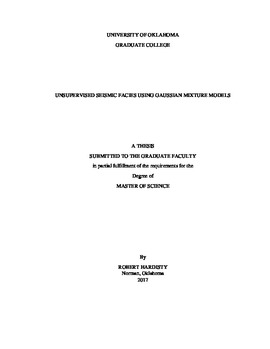| dc.contributor.advisor | Marfut, Kurt | |
| dc.contributor.advisor | Wallet, Brad | |
| dc.contributor.author | Hardisty, Robert | |
| dc.date.accessioned | 2017-08-11T15:37:51Z | |
| dc.date.available | 2017-08-11T15:37:51Z | |
| dc.date.issued | 2017-08 | |
| dc.identifier.uri | https://hdl.handle.net/11244/51904 | |
| dc.description.abstract | ABSTRACT
As the use of seismic attributes becomes more widespread, multivariate seismic analysis has become more commonplace for seismic facies analysis. Unsupervised machine learning techniques provide methods of automatically finding patterns in data with minimal user interaction. When using unsupervised machine learning techniques such as K-means or Kohonen Self-Organizing Maps, the number of clusters can often be ambiguously defined and there is no measure of how confident the algorithm is in the classification of data vectors. The model-based probabilistic formulation of Gaussian mixture models (GMMs) allows for the number and shape of clusters to be determined in a more objective manner using a Bayesian framework that considers a model’s likelihood and complexity. Furthermore, the development of alternative Expectation-Maximization algorithms has allowed GMMs to be more tailored to unsupervised seismic facies analysis. The Classification Expectation-Maximization algorithm classifies data vectors according to their posterior probabilities that provides a measurement of uncertainty and ambiguity (often called a soft classification). The Neighborhood Expectation-Maximization algorithm allows for spatial correlations to be considered to make classification volumes more realistic by enforcing spatial continuity. Co-rendering the classification with the uncertainty and ambiguity measurements produces an intuitive map of unsupervised seismic facies.
I apply a model-based classification approach using Gaussian mixture models to a turbidite system in Canterbury Basin, New Zealand to clarify results from an initial Self-Organizing Map and highlight areas of uncertainty and ambiguity. Special focus on a channel feature in the turbidite system using a Neighborhood Expectation-Maximization algorithm shows it to be more realistic by considering spatial correlations within the data. I also use this model-based classification approach to highlight structural features on top of a Miocene submarine volcano in the Taranaki Basin, New Zealand. | en_US |
| dc.language | en_US | en_US |
| dc.subject | Unsupervised machine learning | en_US |
| dc.subject | Seismic facies | en_US |
| dc.subject | Seismic attributes | en_US |
| dc.subject | Seismic interpretation | en_US |
| dc.title | Unsupervised seismic facies using Gaussian mixture models | en_US |
| dc.contributor.committeeMember | Slatt, Roger | |
| dc.date.manuscript | 2017-07 | |
| dc.thesis.degree | Master of Science | en_US |
| ou.group | Mewbourne College of Earth and Energy::Conoco Phillips School of Geology and Geophysics | en_US |
